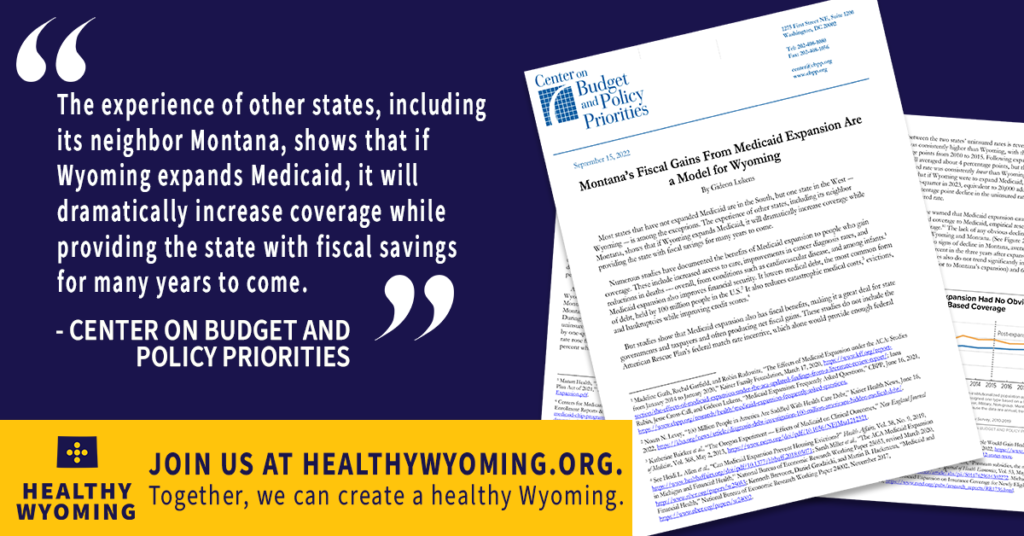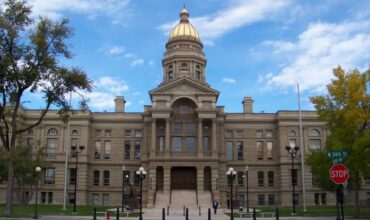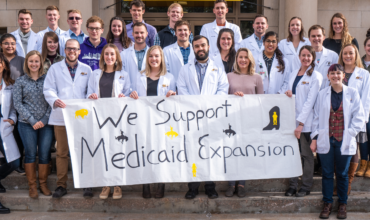The Joint Revenue Committee of the Wyoming Legislature is scheduled to discuss Medicaid expansion on Tuesday, Nov. 22 at 9 a.m.
CHEYENNE, Wyo. – Expanding Medicaid in Wyoming will dramatically increase coverage while providing the state with fiscal savings for many years, according to a recent report by the Center on Budget and Policy Priorities.
The report examines the impact of Medicaid expansion on Montana and concludes that Montana’s experience highlights the fiscal benefits Wyoming could expect. The center issued the report in September 2022. View the full report at https://www.cbpp.org/research/health/montanas-fiscal-gains-from-medicaid-expansion-are-a-model-for-wyoming
“This report dispels the ongoing myth that Medicaid expansion harms state governments,” said Bruce Palmer who is part of the Healthy Wyoming coalition. “Montana has dramatically increased coverage while providing the state with fiscal savings.”
Palmer encouraged those interested in supporting Medicaid expansion in the Cowboy State to join Healthy Wyoming, a broad coalition focused on expanding the Medicaid health insurance program. Visit healthywyoming.org.

Montana is not alone. Nebraska, Utah and Idaho have successfully extended coverage to their low-income residents. In 2019 after three years of experience with expanded Medicaid, Montana’s Republican-led legislature reauthorized the program until 2025.
Just this month, South Dakota voters easily passed a Medicaid expansion ballot initiative becoming the seventh state to expand via ballot initiative Sixty-six percent of Wyoming voters favor expansion, including 58% of Republicans.
The Center on Budget and Policy Priorities, a nonpartisan research and policy institute, focused its comparison on Montana, which implemented Medicaid expansion in 2016.
REPORT HIGHLIGHTS
Rapid drop in uninsured with no decline in employer coverage. After Montana implemented its expansion on January 1, 2016, the uninsured rate fell steeply while in contrast Wyoming’s has increased steadily throughout the same period. In Wyoming, more than half of those covered by Medicaid expansion would be low-income women. Wyoming has one of the nation’s highest uninsured rates for women of childbearing age.
Medicaid expansion brings federal tax dollars back to states while providing fiscal savings. Studies of Montana’s expansion estimate that it recouped enough savings within Medicaid to cover between 23 and 68% of the state cost of expansion in 2019. Wyoming would save roughly 50% more than Montana for each enrollee that shifts from an existing group to the expansion group. In Montana, savings outside the Medicaid program have been estimated to equal 17 percent of expansion costs. These savings accrue via Montana’s mental health and services program, substance use disorder treatment, and reimbursement for inmate hospitalizations.
Expanding Medicaid reduces the burden on emergency rooms and hospitals. When people lack coverage, they often seek treatment at the emergency room, which comes with a hefty price tag. Expanding coverage helps reduce the burden on emergency rooms, hospitals and providers. For example, uncompensated care in Montana dropped from $143 million in 2015, prior to expansion, to $89 million in 2019. This equates to a 44 percent decline in uncompensated care costs as a share of hospital operating expenses. In contrast, Wyoming’s uncompensated care costs increased from $96 million to $106 million over the same period. By 2019, Wyoming’s uncompensated care costs were almost three times Montana’s as a share of hospital operating expenses.




